
“The fate of bridges is to be lonely, because bridges are for crossing, not for staying.”
…Mehmet Murat Ildan, Turkish poet
At the foot of Rome’s Via Marmorata – so called for the shipments of marble that were unloaded at the docks there in ancient times – stands the Ponte Sublicio. This graceful, triple-arched bridge is a descendant and namesake of the first span ever built by the Romans over the turgid waters of the Tiber.
Livy writes that Ancus Martius, fourth king of Rome (641-616 B.C.), linked the Janiculum Hill to the city by means of a wooden bridge. This was done, Livy claims, to keep that lofty ridge on the opposite bank from falling into the hands of some future enemy:
“Ianiculum quoque adiectum, sed ne quando Ea arx hostium est.”
An already age-old belief that the raising of a bridge would constitute an act of impiety and insult to Father Tiber, the river god, caused the Romans to use only wooden beams for its fabric. The idea seems to have been that the deity might pardon a project that appeared to be temporary; but that a more sturdy one of brick and mortar would provoke him into raining down some dire consequences on Rome. Such a safe means of getting across his realm would rob him of a certain number of victims who would otherwise lose their lives in the effort.
________________________________
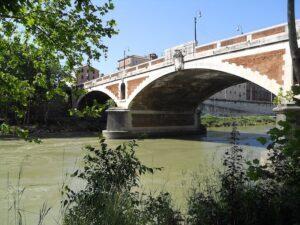
Originally built of wooden beams, the later version , known as Ponte Sublicio, as seen today. Zebra.71, Creative Commons Attribution-Share Alike 4.0 International, Wikimedia Commons
________________________________
The Volscian word for wooden beams, sublicae, gave Rome’s first bridge its name. As a further precaution, Ancus Martius entrusted the superintendence of the Sublician Bridge to a college of priests, bestowing on them the title of pontifices, bridge builders. Their leader was addressed as Pontifex Maximus, the chief bridge builder, or, as the title later came to imply, Rome’s highest ranking priest. The term was symbolic and metaphorical as well, for it was hoped that these clerics would be able to “bridge” the divide between man and divinity. (Julius Caesar once held the office of Pontifex Maximus. And from the earliest time, the Roman Catholic Church adapted the term as the official Latin title of the Bishop of Rome, i.e. the Pope.)
Numerous strange superstitions and rituals were early associated with the Pons Sublicius (Latin). Strangest of all was the annual procession of young veiled maidens led by the pontiffs and the Vestal Virgins on the Ides of May. This somber pageantry wound its way slowly along the narrow, dusty lanes that passed for Rome’s early streets and culminated in sacred ceremonies on the bridge.
Then, to the accompaniment of hymns and chants and prayers, thirty burly men would step forward, each bearing a clumsy straw effigy of himself. At a signal given by the Vestal mother superior, they would cast their likenesses into the rushing stream below – trusting that Father Tiber would be satisfied with these “straw sacrifices” as he once was with the thirty victims that in days gone by were annually hurled into the Tiber as human sacrifices.
Barely a century after the structure’s debut, Rome found itself in a struggle for its very survival against an imminent incursion from the north. Lars Porsena, an Etruscan tyrant, was fast approaching with many regiments of battle-honed warriors. After easily overwhelming the Roman garrison on the summit of the Janiculum, the Etruscans encamped there for the night. Panic gripped the people of Rome as they watched the campfires dancing against the ink-black sky.
The following morning, as his countrymen braced for the worst, a military officer, Horatius Cocles (one-eyed) so-named because he had lost an eye in previous combat, came up with a last-ditch plan: deny the enemy access to Rome by destroying the only bridge that led across the river.
Inviting two valiant fellow soldiers – Spurius Lartius and Titus Herminius – to join him in his soon-to-be heroic stand, Horatius dashed to the far end of the narrow bridge and prepared to hold off the entire Etruscan army, three men at a time, while the rest of the Roman soldiers frantically tore the wooden span down behind them.
As soon as Horatius saw that only a single beam remained that could afford passage, he ordered his two companions to run back across it to the safety of the far bank while he held off the Etruscans single handedly. When Spurius and Titus had made it to shore, the final beam was torn down, and the Romans began to call to Horatius to jump into the river and swim to shore – which he did under a storm of spears and arrows.He miraculously reached the left bank where he was hauled ashore by a tumultuous crowd of thankful Romans.
Until the very fall of the Western Roman Empire in A.D. 476, Horatius Cocles was looked upon as the paragon of Roman valor and patriotism. Every Roman schoolboy was expected to know by heart the details of the epic story of Horatius at the Bridge.
Following this legendary episode, a replacement bearing the same name was constructed at the same location. Livy records how the Tribunus Plebeius, Gaius Gracchus, fled for his life across the planks of the new Pons Sublicius when he learned that the Senate had ordered his assassination because of his ongoing efforts to force wealthy landowners to divide their lands among the plebeians. Gaius – whose older brother Tiberius Gracchus had been killed a decade earlier for pushing for the same land reforms – and his faithful aide, Filocratis, successfully fled across theTiber where they hoped to seek sanctuary in the Sacred Woods of the goddess Furrina (a site which since the Renaissance has been known as the Villa Sciarra). When, however, Gaius heard their pursuers running across the wooden planks of the bridge, he realized they would never make it. To control his own destiny Gaius let himself be slain by Filocratis, who then took his own life.
While there is little doubt that the Pons Sublicius was destroyed repeatedly by flood waters during Roman times, there are but two recorded instances: one in 23 B.C. and another during the principate of Antoninous Pius (A.D. 138-161). In writings from the late Middle Ages there are references to “pons fractus iuxta marboratam”, i.e. a collapsed bridge at Via Marmorata.
An early Renaissance replacement must have rested on piers of stone, for on July 23, 1484, according to a diary from that epoch, Pope Sixtus IV used the stones from these piers to make hundreds of huge travertine cannon balls for the Papal army.
*Ancus Martius’ bridge, of course, continued to be rebuilt each time that it was destroyed, either by soldiers, floods, or stonemasons. The current span, called Ponte Sublicio in Italian, was built in 1918. As a Tiber crossing, it is as vital to the City of Seven Hills today as its ancient forebears were, joining the teeming transpontine districts of Trastevere and Monteverde with the working-class neighborhoods of Testaccio and Ostiense.
The inhabitants of these zones in antiquity grew accustomed to the occasional pleasant clip clop of horse traffic traversing the boards of the Pons Sublicius. Contemporary residents have made their peace with the relentless buzzing of spiffy motor scooters, the frequent wheezing of asthmatic buses, the nerve-shattering honking of impatient Fiats.
Through it all, though, pedestrians strolling on the Ponte Sublicio who know their Roman history cannot help but reflect on the verses of Macauley written in the early 20th century:
“And wives still pray to Juno
For sons with hearts as bold
As his who kept the bridge so well In those gallant days of old.”
Several miles upstream from the Sublician, the Mulvian Bridge still carries the Via Flaminia over the Tiber and sends it on its way to northeastern Italy. Built by the consul Aemilius Scaurus a hundred years before the birth of Christ, the Pons Mulvius – as it was known by the ancient Romans – rests on six graceful sixty-foot high arches. Such great bridges of stone were to become a significant accomplishment of early Roman engineers.
It was on this very span where Pompey and his soldiers withstood an attempted assault on the city by the troops of Lepidus.
_____________________________
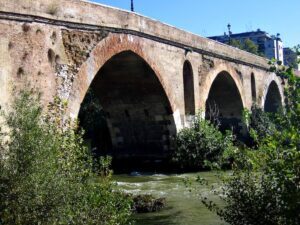
Ponte Milvio. Creative Commons Attribution 2.0 Generic, Wikimedia Commons
_____________________________
The Mulvian Bridge (Ponte Mulvio in modern Italian; some call it Ponte Milvio) was also to serve as the stage for two later dramatic events: one that would breathe a few more years of life into the moribund Roman Republic, another that would forever transform the world.
In the late autumn of 63 B.C., Catiline and his revolutionaries aimed to overthrow the government. Cicero, one of the consuls of that year, was informed by a delegation of the Allobrogians, a Gallic tribe from the upper Rhone, that they had been invited to help in the revolution. The envoys who had come to Rome to protest to the Senate the tyranny of their Roman provincial governor, were encouraged to obtain the request in writing and to go along with a secret plan.
Cicero then summoned the praetors, Lucius Flaccus and Gaius Pomptinus, to set up a sting operation at the Mulvian Bridge. On the chilly night of December 2, each praetor with a squad of state police took up positions in the woods on either bank of the river.
The Allobrogians had meanwhile arranged a rendezvous on the bridge with a small group of Catiline’s henchmen, at which time they would receive documents ostensibly to take back to their people in Provincia Romana (the region of France now called Provence).
Since this was the normal route by which the envoys would have headed home, the conspirators suspected nothing.
At the moment these letters were handed over to the Allobrogians, the praetors and their escorts emerged from the shadows and arrested all the parties. The envoys, of course, were released with the gratitude of the authorities and a promise that their grievances would be addressed by the Senate at once. The hapless revolutionaries were taken to the Mamertine Prison and executed two days later.
In an address to the Senate, Cicero tells of the successful entrapment:
“Interim tertia fere vigilia exacta, cum iam pontem Mulvium magno comitatu legatos Allobrogum ingredi inciperent,unaque Volturcius, fit in eos impetus.”
(Meanwhile, the third watch was just about over. When the Allobrogian diplomats reached the Mulvian Bridge with a large entourage, along with Volturcius, an attack was carried out upon them.)
(Note: Volturcius led the Catiline committee at the meeting).
The incident broke open the Catilinarian conspiracy. The following month Catiline and his poorly equipped, ill-trained forces were crushed in a battle on the plains of Etruria (today’sTuscany).
Three and a half centuries later, Ponte Mulvio became the setting for another civil war. In A.D. 306 Maxentius Valerius, with the support of the dreaded Praetorian Guard, set himself up as emperor of the Roman world. After several years under the harsh rule of Maxentius, the people of Rome repeatedly implored the popular general Constantine for help.
Advertisement
At the time stationed in Gaul, Constantine was at last persuaded by these pleas to set out with his legions for Rome. After vanquishing the forces of Maxentius in a battle near Torino and in another on the outskirts of Verona, Constantine descended on the imperial capital. Maxentius held his cavalry in reserve while his infantry engaged Constantine’s army sweeping down the Via Cassia.
By early fall, Constantine was encamped just over the Ponte Mulvio from the main part of the city. At noon on October 26, the day before the all-out war for control of Rome, he saw in the skies above the bridge a cross of light encircled by the words: “In hoc signo vinces.” In this sign thou shalt conquer!
The astounded general then ordered his troops to paint their shields with “the symbol of the Cross.” He replaced the Roman eagle atop his standard with the cross of Christ. (A silver medallion struck in 315 shows Constantine wearing the new symbol on his helmet.)
On the following morning, Maxentius foolishly left the safety of the city and its walls and crossed the Tiber to intercept the enemy. His troops, however, were quickly seized with panic and rushed back to the bridge whose railings gave way to the sudden crush of humanity, precipitating all who were on it into the dark, swirling waters below. One of these was Maxentius himself, who soon drowned from the weight of his own armor. Constantine marched his victorious soldiers over the badly damaged bridge and into the city where he was greeted with the thunderous adulation of a grateful populace.
____________________________
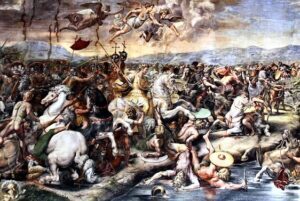
The Battle of Milvian Bridge. Painting by Giulio Romano, Public Domain, Wikimedia Commons
____________________________
Attributing his success to the God of the Chrtistians, Constantine soon after expressed his gratitude by issuing his historic Edict of Milan granting the flock of Christ freedom of worship. It is widely believed that Constantine and his entire family, including his mother Helena, were eventually swayed themselves from paganism to Christianity.
All of this we learn from the historian Eusebius, who praised the emperor in his work “On the Life of Constantine.” In an interview, Constantine had told the writer the details of his vision of the Cross and vouched for its truthfulness with a solemn oath.
In 317 the Roman Senate erected the still-standing Arch of Constantine just across the street from the Colosseum. Some of this monument’s bas-reliefs commemorate the momentous clash at the Pons Mulvius. Later that year Constantine placed nearby a statue of himself holding the Cross as a standard. Fragments of this colossus now adorn the courtyard of the Capitoline Museum.
Just a few yards from the venerable old bridge now stands the Church of the Holy Cross. This modest edifice was commissioned by Pope Pius X in 1912 to mark the sixteen hundredth anniversary of the event that changed Rome and the world forever.
Other touches of Christian imagery had earlier been added to the bridge itself. Baroque statues of the Savior and John the Baptist guard one end of the Ponte Mulvio, while effigies of the Virgin Mary and St.John Nepomycene watch over the other.
Pope Pius VII in 1815 had the French architect Valadier fashion the triumphal gate that is to be seen at the northern end.
Today all is serene at the historic Mulvian Bridge. About the only activity one notices is old men lined up along the balustrade with their fishing rods, hoping for a bite from the waters swishing through the six lovely brownstone arches below.
We come now to our next Tiber bridge which, thanks to the hordes of English-speaking tourists, enjoys the felicitous name of ”Bridge of the Angels.” This span too has a long pedigree and its share of lore.
First, some background. Here, at about mid-stream of the river’s course through the Eternal City, the Emperor Hadrian (Publius Aelius Hadrianus). A.D. 117-138, decided to erect on the right bank, a gargantuan mausoleum for himself, his family, their descendants, and successive rulers and their clans. This architectural wonder still looms over the scene, mostly intact. Following the completion of the tomb, around 136, Hadrian commissioned the architect Demetrianus to build a monumental access to the imperial mausoleum which he named the Pons Aelius. That name survived until the year 590.
At that time a plague was devastating Rome, wiping out half the population as it raged. One night, Pope Gregory the Great led a candlelight procession through the streets, invoking Heaven to grant relief. The multitude of participants with Gregory at the front were headed for St.Peter’s over in the Vatican. When he was about to cross the Pons Aerlius, the pontiff saw, atop the mausoleum, a vision of an angel putting his bloody sword back into its sheath. The next day the plague lifted. Rome and her people were spared. Pope Gregory interpreted the apparition as a sign that Heaven answered by sending Michael the Archangel to kill the pestilence. Gregory soon had a replica in marble placed at the spot of his vision. He then renamed the vast structure, Castel Sant Angelo, Castle of the Holy Angel. The bridge became known as Ponte Sant Angelo, and would from then on serve as the main span for conveying eager throngs of pilgrims over the Tiber to St.Peter’s.
_______________________________
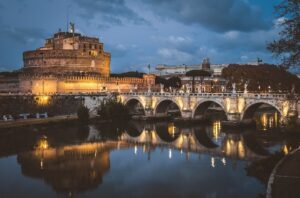
The Ponte Sant’Angelo. Martieda, Pixabay
_______________________________
Even Dante, who was a pilgrim himself in the Holy Year of 1300, mentions this in his Divine Comedy (Inferno XVIII-31-33). Built on five exquisitely lovely arches, Ponte Sant Angelo remains proudly intact from antiquity.
In 1535 Pope Clement VII ordered two statues to be placed at the foot of the bridge, one of St.Peter (by Lorenzetto), the other of St.Paul (by Paolo Taccone).
Clement IX in the next century had Gian Lorenzo Bernini and his prized students adorn the bridge with ten statues of angels, each bearing a symbol of Christ’s Passion: one bearing nails, another the whip with which Christ was scourged, a third holding the Crown of Thorns, another the lance which pierced his side, and so on.
Perhaps the English-speaking visitors have it right after all. This is truly “The Bridge of the Angels..”
Downstream a distance brings us eventually to Isola Tiberina, the miniature island in the Tiber. Since the fifth century B.C., when Aesculapius the Greek god of medicine is said to have chosen this site for Rome’s first hospital, the island has been used for such a purpose. Today a fine medical facility takes up most of the isle and is under the administration of a religious order of brothers.
Where the temple to the medicine deity once stood there rises today the tenth century church of San Bartolomeo where the priests maintain that the body of the apostle Bartholomew lies beneath the main altar.
Two ancient bridges link the island to either side of the city. The Ponte Fabricio, 62 B.C., connects it to the left bank where one finds the old historic Jewish Quarter of Rome and its imposing Synagogue. Ponte Cestio, 46 B.C., links the boat-shaped Isola Tiberina to the right bank and the colorful Trastevere district.
____________________________

Isola Tiberina, aerial view. European Commission, Wikimedia Commons
____________________________
And lastly, and perhaps fittingly, we come to what is popularly called Ponte Rotto, Broken Bridge. The term “Archaeology” derives from two Greek words meaning “the study of old things.” But what such an enterprise usually turns out to be is more accurately: the study of “parts” of old things (e.g. the Colosseum, the Forum, the Baths of Caracalla, and so on). And this is what we now study: the remaining part of a once truly beautiful bridge, the Pons Aemilius Lepidus from A.D. 179. This relic you may behold from a fairly close vantage point, by standing on the modern, steel Ponte Palatino which runs along side it.
Battered by fierce floods throughout the ages, the Aemilian bridge was repeatedly restored to even finer beauty. But in 1598 Rome was pounded with relentless spring downpours. In the fury of the resultant raging river more than half the renowned span was swept away and was never again to be restored. But even today in its lonely mournful ruins, the fragmented Pons Aemilius Lepidus stands proudly testifying to the “Glory that was – and is – Rome.”
___________________________
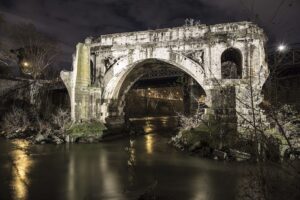
The Ponte Rotto. Dankayes, Creative Commons Attribution-Share Alike 4.0 International, Wikimedia Commons
___________________________
Advertisement

Don’t miss out on this unforgettable evening as Dr. Hawass reveals the most closely guarded secrets of ancient Egypt and presents his groundbreaking new discoveries and latest research live on stage. As the man behind all major discoveries in Egypt over the last few decades and director of several ongoing archaeological projects, Dr. Hawass may yet surprise you with unexpected revelations that will make news across the world.
___________________________





